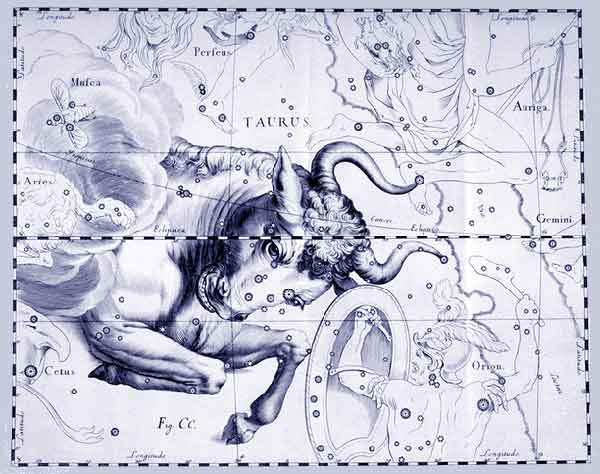
MYTHOLOGY
Created in Mesopotamia after the 4380 a.c., when the equinox fell in this portion of the sky, it was the constellation that inaugurated the zodiacal year then; it evoked the symbol of a primordial and celestial energy, in fact in sumero was called GU.AN.NA, "Taurus of the sky", or GU.SI.DI., "Taurus conductor": sacred animal to the lunar divinity (that he was male), or its symbol. According to a cretese archaic myth a Taurus came place in sky because it had transported easy Europe until Creta: Europe would represent the fertilized feminine principle from the male principle, that is the Moon kidnapped from the solar Taurus. An other myth narrated instead that Io, changed in young cow from Zeus because the wife Era was jealous it did not discover the new loving, was putted for repair in sky where the front part of its body appears like a Taurus while the rest is not visible. Here the Taurus is symbolically assimilated the Great Mother. The more luminous star of the Taurus is Aldebaran, that it means in Arab "who follows",in the sense that follows the Pleiadi in the appearing celestial movement. The Greeks had mysteriously not attributed some name to them, although its striking red color. In correspondence of the left horn there is the star Elnath, "the clash" in Arab. IADI: this small small group of seven stars disposed to "V" in correspondence of the snout of the Taurus represented for the Greeks seven sisters nymphs, been born from Atlas and a Oceanina (Etra): they had been the nurses of Dioniso in a cavern of the mount Nisa where Zeus had transported the child, fruit of the love adulterates with Semele, in order to save it from the persecution of the jealous Era: so they were calls Nisiadi nymphs. They came then transformed for rewards in the Iadi stars. An other myth narrated that the young people had killed themselves for the dead of the Iante brother: in order to remember their deep love , they were transformed in the constellation of the Iadi, whose derives from the verb yein, "to rain", since their apparition coincided in the antiquity with the season of rains. PLEIADI: Also this small small group of seven stars for the Greeks represented seven sisters, daughters of Atlante and Pleione: all had joined to divinity having generated others Gods and heroes, except the Merope, less luminous than all, perhaps exactly for the shame. On their metamorphosis in stars were told numerous history: Apollodoro reported that, being been particularly wise, they had obtained the honor of immortality with the name of Pleiadi. Igino in its turn narrated that Pleione and the seven daughters, a day, while they crossed the Beozia, were attacked from the giant Orione that wanted to possess them or, according to an other version of the myth, love the mother. They succeeded miraculously to escape, but from that day the hunter continued to chase them (in fact the two constellations are near in the sky) for five years, until Zeus, transformed them to stars. Their name, derives from plein, "to be navigate", because they marked after the winter the arrival of the propitious time to navigation; or pleion, "plus", because they were numerous; or in Greek derived from peleiades, "flock of doves", because before becoming stars they would have been transformed from Zeus in these birds in order to escape more easy to Orione.